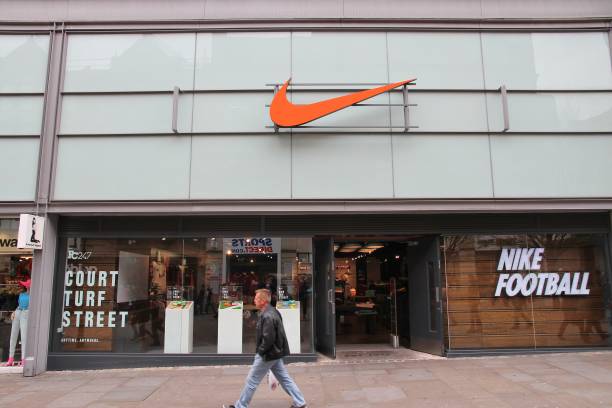Nike, founded in 1964 as Blue Ribbon Sports and later renamed in 1971, is a globally recognized and highly influential brand in the sportswear and athletic equipment industry. With its iconic swoosh logo and the renowned “Just Do It” slogan, Nike has become synonymous with excellence, innovation, and empowerment.
Over the years, Nike has grown to become a dominant force, setting trends and pushing boundaries in sports fashion, footwear, and equipment.
Through a combination of cutting-edge technology, strategic marketing, athlete endorsements, and a commitment to social responsibility, Nike has solidified its position as a market leader, inspiring athletes and consumers worldwide to unleash their full potential.
Marketing Strategies of Nike
Nike has consistently set the benchmark for innovative and impactful marketing strategies. By employing a combination of brand storytelling, athlete endorsements, digital campaigns, and community engagement, Nike has managed to capture the hearts and minds of consumers worldwide. In this article, we will delve into the key elements of Nike’s marketing strategies that have contributed to its unparalleled success.
Powerful Brand Storytelling: Nike’s brand storytelling is centered around the core concept of empowerment. The company has consistently used its marketing campaigns to highlight stories of real athletes who have overcome challenges and achieved greatness. By showcasing these stories, Nike creates an emotional connection with consumers, inspiring them to pursue their own dreams and goals. The “Just Do It” slogan, introduced in 1988, encapsulates the brand’s message of taking action and pushing boundaries, resonating with individuals across different age groups and demographics.
Nike’s advertisements often portray athletes in authentic and relatable situations, capturing the dedication, passion, and sacrifices they make to succeed. For example, the iconic “Find Your Greatness” campaign showcased ordinary people engaging in sports and physical activities, emphasizing that greatness can be achieved by anyone, regardless of their starting point. By emphasizing the power of the human spirit, Nike’s brand storytelling instills a sense of motivation and aspiration within consumers.
Strategic Athlete Endorsements: Nike has a long history of partnering with top athletes, both established superstars and rising stars. These endorsements serve multiple purposes for Nike’s marketing strategy. First, they reinforce the brand’s association with excellence and performance. When consumers see their favorite athletes wearing Nike products, they perceive the brand as a symbol of success and superiority.
Second, athlete endorsements help Nike target specific market segments. By selecting athletes from different sports and backgrounds, Nike can connect with a diverse range of consumers who identify with those athletes. For example, partnering with basketball legend Michael Jordan allowed Nike to dominate the basketball market and establish the highly successful Jordan brand. Similarly, collaborations with Serena Williams and Cristiano Ronaldo help Nike tap into the tennis and soccer markets, respectively.
Nike’s athlete endorsements extend beyond advertising and product promotion. The company often supports athletes in their philanthropic efforts and provides them with opportunities to contribute to social causes, further enhancing the brand’s reputation and social impact.
Cutting-Edge Digital Campaigns: Nike has been at the forefront of digital marketing, recognizing the importance of online platforms in reaching and engaging with consumers. The company leverages various digital channels, including social media, websites, mobile apps, and digital content, to create interactive and immersive experiences.
Nike’s digital campaigns often incorporate gamification, AR, and VR technologies to enhance user engagement. For instance, the Nike Training Club app offers personalized workout plans, instructional videos, and tracking features, allowing users to train like professional athletes in the comfort of their homes. Nike also launched the Nike SNKRS app, which provides an interactive experience for sneaker enthusiasts, including access to limited-edition releases, behind-the-scenes content, and exclusive offers.
Furthermore, Nike utilizes social media platforms to connect with its audience on a more personal level. The brand encourages user-generated content and hashtags, enabling consumers to share their athletic achievements, fitness journeys, and Nike product experiences. This user engagement not only strengthens the Nike community but also generates valuable brand advocacy and word-of-mouth marketing.
Influencer Marketing and Collaborations: Nike recognizes the impact of influencer marketing and collaborations to expand its reach and appeal. The brand strategically partners with influential individuals from various fields, including sports, fashion, music, and entertainment.
Nike collaborates with designers, artists, and celebrities to create limited-edition collections or unique product designs. These collaborations generate excitement and exclusivity around Nike’s offerings, driving both sales and brand visibility. For example, collaborations with renowned designers like Virgil Abloh’s Off-White and sacai have resulted in highly sought-after sneakers and apparel collections that merge sports and fashion.
Nike also engages with social media influencers and content creators who have a strong following and influence in specific niches, such as fitness, lifestyle, and streetwear. By partnering with these influencers, Nike can tap into their dedicated fan bases and gain exposure to new audiences.
Community Engagement and Corporate Social Responsibility: Nike places a strong emphasis on community engagement and corporate social responsibility (CSR) initiatives. The company believes in the power of sports to drive positive change and focuses on initiatives that promote inclusivity, youth development, and access to sports opportunities.
Nike Community Impact is an umbrella program that encompasses various initiatives aimed at making sports accessible to underserved communities. The programs include providing resources and support to community organizations, sponsoring youth sports teams, and investing in infrastructure improvements for local sports facilities.
Nike’s “Made to Play” initiative aims to inspire and enable more children to participate in physical activity. The program focuses on removing barriers to play and supports projects that encourage active lifestyles among children, such as building safe playgrounds and organizing sports events.
By actively engaging in community initiatives and promoting social causes, Nike demonstrates its commitment to making a positive impact beyond its products. This approach strengthens the brand’s reputation, fosters consumer loyalty, and attracts socially conscious consumers who align with Nike’s values.
Nike’s marketing strategies are a combination of powerful brand storytelling, strategic athlete endorsements, cutting-edge digital campaigns, influencer collaborations, and community engagement. These elements work together to create a cohesive and impactful brand image, enabling Nike to maintain its position as a leader in the global sportswear market. By inspiring individuals, connecting with consumers on a personal level, and demonstrating a commitment to social responsibility, Nike has successfully built a brand that resonates with athletes and non-athletes alike, fostering a strong emotional connection that transcends mere product offerings.
Marketing Mix of Nike
Nike has established itself as a dominant force in the industry. A key factor contributing to Nike’s success lies in its effective marketing mix. The marketing mix, also known as the 4Ps (Product, Price, Place, and Promotion), encompasses the strategic decisions and tactics employed by Nike to reach and satisfy its target market. In this article, we will delve into each element of Nike’s marketing mix and explore how it has propelled the brand’s growth and market dominance.
Product: At the core of Nike’s marketing mix is its exceptional product portfolio. Nike offers a wide range of products, including athletic footwear, apparel, equipment, and accessories. The company’s product strategy focuses on innovation, quality, and performance, positioning Nike as a premium brand.
Nike continuously invests in research and development to introduce cutting-edge technologies and materials in its products. Examples include Nike Air cushioning, Flyknit fabric, and Dri-FIT moisture-wicking technology. These product innovations provide athletes and consumers with superior performance, comfort, and style, giving Nike a competitive edge in the market.
Furthermore, Nike’s product line extends beyond traditional sports gear. The brand has successfully ventured into lifestyle and fashion segments, introducing sneakers and apparel that appeal to a broader consumer base, not limited to athletes. Nike’s collaborations with designers, celebrities, and influencers further enhance the desirability and exclusivity of its products.
Price: Nike employs a premium pricing strategy, positioning itself as a high-quality and aspirational brand. The company’s pricing decisions are influenced by factors such as production costs, market demand, competitor pricing, and perceived value.
While Nike’s products are often priced at a premium compared to competitors, the brand’s strong reputation and perceived value justify the higher price points. Consumers are willing to pay a premium for Nike products due to the association with quality, performance, and the brand’s iconic status.
Nike also utilizes a pricing strategy that aligns with different product categories and target markets. For instance, the brand offers a range of price points, from entry-level options to high-end, limited-edition collections. This pricing flexibility allows Nike to cater to a diverse customer base and capture various market segments.
Place: The “Place” element of Nike’s marketing mix refers to the distribution channels through which the company brings its products to the market. Nike utilizes a multi-channel distribution strategy, encompassing both physical and online channels.
Nike operates its branded retail stores globally, providing a direct-to-consumer experience. These stores serve as flagship locations where consumers can explore Nike’s entire product range and engage with the brand in an immersive environment. Nike’s flagship stores often incorporate digital technology, interactive displays, and experiential elements to enhance the customer journey.
In addition to its own retail stores, Nike leverages various distribution channels, including department stores, specialty athletic retailers, and e-commerce platforms. By partnering with select retailers, Nike expands its reach and ensures availability across different geographical locations.
Nike’s online presence is a critical component of its distribution strategy. The brand operates its official e-commerce platform, offering a seamless online shopping experience and direct access to its product range. Furthermore, Nike engages with third-party e-commerce platforms and social media channels to maximize its online visibility and accessibility.
Promotion: Nike’s promotion strategy revolves around building a powerful brand image, engaging consumers, and driving demand for its products. The brand employs a diverse range of promotional tactics to reach its target market effectively.
Nike’s marketing campaigns are centered on captivating storytelling, leveraging the brand’s association with sports, athleticism, and inspiration. Through emotionally charged advertisements and digital campaigns, Nike tells stories of real athletes, highlighting their journeys, challenges, and triumphs. This storytelling approach creates a strong emotional connection with consumers, fostering brand loyalty and advocacy.
Nike also invests significantly in athlete endorsements and sponsorships. By partnering with high-profile athletes across different sports, Nike enhances its brand credibility and connects with consumers who idolize these athletes. Nike’s sponsored athletes often feature prominently in marketing campaigns, product launches, and events, reinforcing the brand’s association with excellence and performance.
Furthermore, Nike embraces digital marketing channels and social media platforms to engage with consumers directly. The brand leverages user-generated content, influencer collaborations, and interactive experiences to foster community engagement and generate buzz around its products.
Nike’s marketing mix is a strategic blend of product excellence, premium pricing, widespread distribution, and impactful promotion. By consistently delivering innovative and high-quality products, maintaining a premium brand image, optimizing distribution channels, and captivating consumers with emotionally driven campaigns, Nike has successfully positioned itself as a leader in the global sportswear industry. The company’s marketing mix continues to evolve, enabling Nike to adapt to changing consumer preferences and maintain its competitive advantage in the market.
Also Read: The Power of Branding: A Look at Nike Iconic Brand Campaigns
To read more content like this, susbcribe to our newsletter



